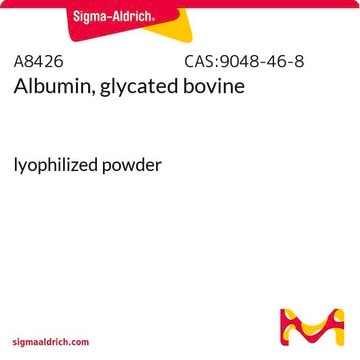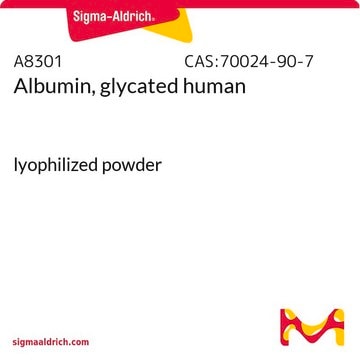121800-M
Advanced Glycation Endproduct-BSA
AGE-BSA has been reported to induce apoptosis in cultured human umbilical vein endothelial cells and inhibit nitric oxide synthase activity in proximal tubular epithelial cells.
Synonyme(s) :
AGE-BSA
Se connecterpour consulter vos tarifs contractuels et ceux de votre entreprise/organisme
About This Item
Code UNSPSC :
12352202
Nomenclature NACRES :
NA.25
Produits recommandés
Niveau de qualité
Pureté
≥95% (SDS-PAGE)
Forme
liquid
Fabricant/nom de marque
Calbiochem®
Conditions de stockage
OK to freeze
avoid repeated freeze/thaw cycles
Température de stockage
−70°C
Catégories apparentées
Description générale
Prepared by reacting BSA with glycoaldehyde under sterile conditions. Glycated-BSA shows a 5,000 - 10,000% increase in fluorescence as compared to normal BSA (confirmed by fluorescence spectrophotometry, excitation/emission 370/440 nm). AGE-BSA has been reported to induce apoptosis in cultured human umbilical vein endothelial cells and inhibit nitric oxide synthase activity in proximal tubular epithelial cells. Advanced glycation end products and their receptors have been implicated in the pathogenesis of diabetes, induction of proinflammatory cytokines, and stimulation of smooth muscle proliferation, and fibronectin production.
Prepared by reacting bovine serum albumin (BSA) with glycoaldehyde under sterile conditions. Fluorescence of AGE-BSA is confirmed by fluorescence spectrophotometry, excitation/emission = 370/440 nm. Glycated BSA shows a 5000-10,000% increase in fluorescence compared to control BSA. AGE and their receptors have been implicated in the pathogenesis of diabetes, induction of pro-inflammatory cytokines, and stimulation of smooth muscle proliferation and fibronectin production. AGE-BSA has also been shown to induce apoptosis in cultured human umbilical vein endothelial cells (HUVEC) and inhibit nitric oxide synthase activity in proximal tubular epithelial cells of the kidney.
Avertissement
Toxicity: Standard Handling (A)
Forme physique
In sterile-filtered PBS.
Autres remarques
Okamoto, T., et al. 2002. Microvasc. Res.63, 186.
Ohgami, N., et al. 2001. J. Biol. Chem.276, 3195.
Wang, R., et al. 2001. J. Nippon Med. Sch.68, 472.
Sakata, N., et al. 2000. J. Atheroscler. Thromb.7, 169.
Verbeke, P., et al. 2000. Biochim. Biophys. Acta1502, 481.
Farboud, B., et al. 1999. Mol. Vis.5, 11.
Huang, J.-S., et al. 1999. Biochem. J.342, 231.
Min, C., et al. 1999. Diabetes Res. Clin. Pract.46, 197.
Neumann, A., et al. 1999. FEBS Lett.453, 283.
Stitt, A.W., et al. 1999. Biochem. Biophys. Res. Commun.256, 549.
Nazaimoon, W. and Bak, K. 1998. Malays. J. Pathol.20, 83.
Ohgami, N., et al. 2001. J. Biol. Chem.276, 3195.
Wang, R., et al. 2001. J. Nippon Med. Sch.68, 472.
Sakata, N., et al. 2000. J. Atheroscler. Thromb.7, 169.
Verbeke, P., et al. 2000. Biochim. Biophys. Acta1502, 481.
Farboud, B., et al. 1999. Mol. Vis.5, 11.
Huang, J.-S., et al. 1999. Biochem. J.342, 231.
Min, C., et al. 1999. Diabetes Res. Clin. Pract.46, 197.
Neumann, A., et al. 1999. FEBS Lett.453, 283.
Stitt, A.W., et al. 1999. Biochem. Biophys. Res. Commun.256, 549.
Nazaimoon, W. and Bak, K. 1998. Malays. J. Pathol.20, 83.
Informations légales
CALBIOCHEM is a registered trademark of Merck KGaA, Darmstadt, Germany
Code de la classe de stockage
12 - Non Combustible Liquids
Classe de danger pour l'eau (WGK)
WGK 2
Point d'éclair (°F)
Not applicable
Point d'éclair (°C)
Not applicable
Certificats d'analyse (COA)
Recherchez un Certificats d'analyse (COA) en saisissant le numéro de lot du produit. Les numéros de lot figurent sur l'étiquette du produit après les mots "Lot" ou "Batch".
Déjà en possession de ce produit ?
Retrouvez la documentation relative aux produits que vous avez récemment achetés dans la Bibliothèque de documents.
Notre équipe de scientifiques dispose d'une expérience dans tous les secteurs de la recherche, notamment en sciences de la vie, science des matériaux, synthèse chimique, chromatographie, analyse et dans de nombreux autres domaines..
Contacter notre Service technique








